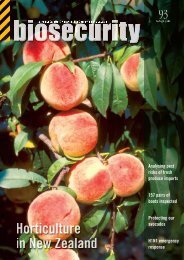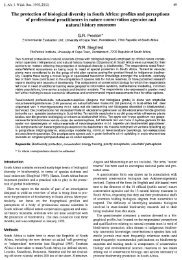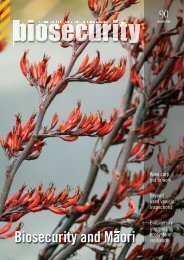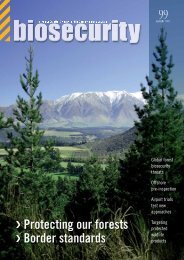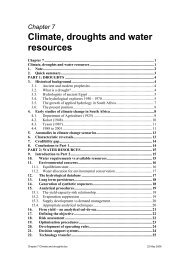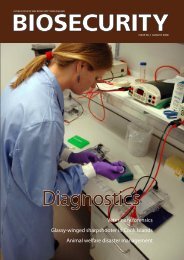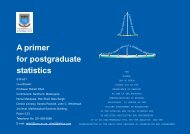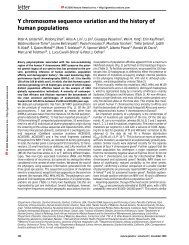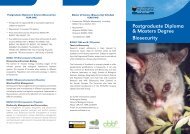Biosecurity magazine - Biosecurity New Zealand
Biosecurity magazine - Biosecurity New Zealand
Biosecurity magazine - Biosecurity New Zealand
You also want an ePaper? Increase the reach of your titles
YUMPU automatically turns print PDFs into web optimized ePapers that Google loves.
92<br />
MARINE<br />
THE “NUMBER-8<br />
WIRE” APPROACH<br />
TO REDUCING<br />
BIOFOULING RISK<br />
Case Study: using hot water<br />
blasting as a low-tech, costeffective<br />
treatment for biofouling<br />
on a large commercial vessel.<br />
While antifouling coatings<br />
are used widely in<br />
commercial shipping for<br />
efficiency gains, fouling organisms can<br />
still occur on specific areas of vessels,<br />
known as niche areas. These include<br />
the dry dock strips on keels, and<br />
seawater intakes and anchor wells.<br />
Manual removal is often the principal<br />
management tool used for the<br />
large-scale control of vessel biofouling,<br />
often involving the scraping of the<br />
vessel’s hull to remove organisms. On<br />
larger or modified vessels, for example<br />
those with dredge arms, this<br />
methodology may not be enough.<br />
MAF <strong>Biosecurity</strong> <strong>New</strong> <strong>Zealand</strong><br />
(MAFBNZ) Senior Adviser (Marine)<br />
Justin McDonald has recently joined<br />
the organisation from the Western<br />
Australian Department of Fisheries.<br />
Prior to this, he worked as a marine<br />
consultant where one of his projects<br />
involved travelling to Singapore to<br />
“clear” a vessel for entry into Australia.<br />
During this “clearance” Dr McDonald,<br />
along with West Australian fisheries<br />
staff, oversaw the use of a hot water<br />
blasting method to deal with niche area<br />
fouling.<br />
The vessel involved was the Lange<br />
Wapper, a trailing suction hopper<br />
dredger around 130 metres long. It was<br />
in dry dock in Singapore and due to<br />
visit Australia. An introduced species<br />
survey was required prior to the vessel<br />
entering Australian waters, with full<br />
examination of all underwater sections<br />
of the dredge.<br />
Worker in bow thruster intake pipe using pressurised boiling water to kill biofouling within bow thruster cavity.<br />
(Note: the pressure cleaner is inserted almost completely within the cavity to target fouling.)<br />
A crew had been assigned to clean the<br />
vessel using traditional scraping<br />
methods prior to the inspection. The<br />
majority of the vessel was scoured<br />
clean and had a new coating of<br />
antifouling paint. The exceptions were<br />
the manually inaccessible areas of the<br />
bow thruster cavity (see photos).<br />
The cavity is part of a sleeve that<br />
encases the bow thruster intakes.<br />
Normally the bow thruster intakes and<br />
cavity are not examined, especially if<br />
an in-water inspection is conducted,<br />
because it requires oxy-acetylene tools<br />
to cut metal bars and climbing into a<br />
relatively narrow tube.<br />
The bow thruster cavity was found to<br />
contain significant colonies of the<br />
recognised pest species the Asian green<br />
mussel (Perna viridis) and two acorn<br />
barnacle species.<br />
As the bow thruster cavity could not be<br />
reached by traditional manual means,<br />
other pest organism treatments, such<br />
as submersion in vinegar (acetic acid),<br />
were considered. Use of a vinegar<br />
solution in a location such as the bow<br />
thruster cavity was, however, restricted<br />
as the method requires immersion of<br />
organisms in the solution for 12 hours<br />
or more. Because of the nature of the<br />
bow thruster and cavity, the immersion<br />
technique was impractical and a<br />
different technique for removing the<br />
organisms was required.<br />
The pressure was on to find a solution<br />
as Singapore Harbour is extremely<br />
busy and the vessel had to be out of dry<br />
dock the next day. There was, however,<br />
no way the vessel would get clearance<br />
to enter Australia in its fouled state.<br />
Using what was at hand, Dr McDonald<br />
and a crew of contractors managed to<br />
route boiling water from the ship’s<br />
boiler to a high-pressure water blaster<br />
cleaner like that used to clean cars.<br />
Hot water has been advocated as a<br />
treatment for ballast water (Mountfort<br />
et al, 1999). The water used in this<br />
instance was 130 celsius at the source<br />
8 MAF BIOSECURITY NEW ZEALAND




